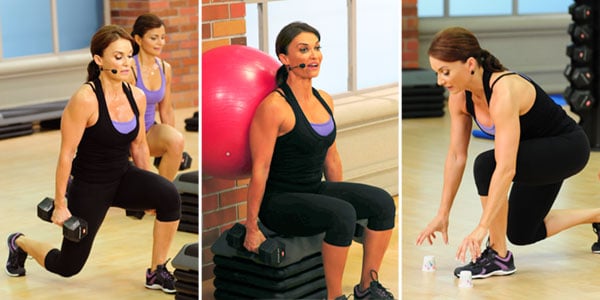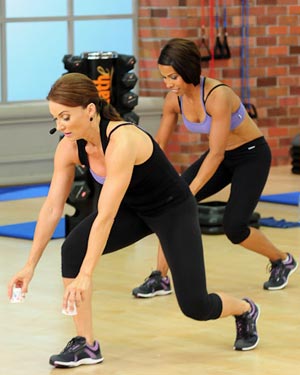
In developing the Low Impact series I spent a lot of time researching and experimenting with alternative exercises and safer ways of doing squats and lunges. Though these two exercises are regarded as probably the two best ways of working your lower body muscle groups, they can be bothersome for those with joint issues.
My new Low Impact series has been designed by me to be used by exercisers that are seeking an advanced high-intensity workout that is more joint friendly than the typical high impact workout of this type.
Now, before I get into more joint-friendly squats and lunge alternatives let me first caution you that the Low Impact series is not a set of rehab workouts and has not been designed for someone needing the expert guidance of a physical therapist or the medical advice of a doctor. Different people have different types of joint issues and it is impossible to make a video that addresses all of these different concerns.
Joint Friendlier Lunges:
The good news for many of you that have joint issues is there are modifications and alternatives that may help you enjoy the benefits of squats and lunges once again. Let’s begin by examining lunges first.
When it comes to a forward lunge there are two main forces that place stress on your knee joints. The first is a downward force that comes from your body weight and any dumbbell or weight you’re using. The second force is from the forward momentum and then the sudden deceleration of stepping forward to do the forward lunge. You can eliminate this second force on your knee by simply doing a back lunge or a split lunge, but you can also still do a front lunge by simply adding a forward lean at the same time you lunge forward. In the picture on the left, you will see me doing a forward lean as I lunge forward engaging more of my glutes which reduces stress on my knee.
The Dixie cups you see me holding are used as markers that will not only remind you to lean forward as you lunge but also help you to determine exactly how far you need
Most people that can’t do a regular forward lunge can do this exercise when they add a forward lean. This is just one of several tips I will share with you in my Low Impact series that can help to make your workouts more joint friendly and enjoyable.
The safest and most joint friendly lunge you can do is a back or split lunge. Since there is no forward or backward momentum on the load bearing knee joint for this exercise you have eliminated one potential problem when you select this exercise. Since the benefits of a forward lunge and a back lunge are similar, you can always substitute a back lunge for a forward lunge if you need to. You can even hold onto a chair as you do this exercise if necessary to further reduce stress on your knee joint.
Joint Friendlier Squats:
Just as we did in a forward lunge you can also do a forward lean to reduce knee stress in both a double and single leg squat. If you have back issues this may not be possible or advisable. You should also only use dumbbells, not a barbell on your back if you have back issues. But check with your doctor first!
As a rule when it comes to a squat the less your knee moves forward the more your glutes are utilized and this results in less stress being placed on your knee joints. This makes the squat more like a deadlift, but still a great lower body workout.
One exercise that many people who have knee joint and minor back issues can do in place of a regular squat is a wall squat using a stability ball. In the picture at the top, you will see me doing a wall squat in my Total Body Tri-Sets workout with a High Step. The only purpose of the High Step, in this case, is to act as a safety net if I were to reach failure during the exercise and to help eliminate unnecessary knee and back stress when setting-up and finishing the exercise. The High Step maximum height should allow your legs to bend at 90 degrees without touching the step.
The advantage of a stability ball wall squat is it helps to eliminate a lot of knee and back stress that normally occurs in a regular squat. This exercise is also easier to learn and to do correctly than is a regular squat which requires greater technique.
So if you still have the heart and strength for high-intensity workouts, but joint pain no longer allows you to do what you love – my new Low Impact series is for you! And remember, you can always use any of the techniques and exercises I have mentioned to modify or substitute Squats and Lunges in the Low Impact series or any of my workouts.
Related Articles By Cathe:
Is Exercise the Key to Joint Health?
How Your Joints Age & What You Can Do to Slow It Down
Are Certain Types of Exercise Bad for Bone Health?
4 Powerful Ways to Protect Your Joints
Does Exercise Reduce Joint Inflammation?
3 Low-Impact Workouts You Can Do at Home

